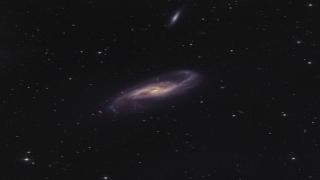Bibcode
James, P. A.; Bretherton, C. F.; Knapen, J. H.
Referencia bibliográfica
Astronomy and Astrophysics, Volume 501, Issue 1, 2009, pp.207-220
Fecha de publicación:
7
2009
Revista
Número de citas
67
Número de citas referidas
61
Descripción
Aims: We analyse the current build-up of stellar mass within the disks
and bulges of nearby galaxies through a comparison of the spatial
distributions of forming and old stellar populations. Methods:
Hα and R-band imaging are used to determine the distributions of
young and old stellar populations in 313 S0a-Im field galaxies out to
~40 Mpc. Concentration indices and mean normalised light profiles are
calculated as a function of galaxy type and bar classification. Results: The mean profiles and concentration indices show a strong and
smooth dependence on galaxy type. Apart from a central deficit due to
bulge/bar light in some galaxy types, mean Hα and R-band profiles
are very similar. Mean profiles within a given type are remarkably
constant even given wide ranges in galaxy luminosity and size. SBc,
SBbc, and particularly SBb galaxies have profiles that are markedly
different from those of unbarred galaxies. The Hα emission from
individual SBb galaxies is studied in detail; virtually all show
resolved central components and concentrations of star formation at or
just outside the bar-end radius. Conclusions: Galaxy type is an
excellent predictor of R-band light profile. In field galaxies, star
formation has the same radial distribution as R-band light, i.e. stellar
mass is building at approximately constant morphology, with no strong
evidence for outer truncation or inside-out disk formation. Bars have a
strong impact on the radial distribution of star formation, particularly
in SBb galaxies.
Based on observations made with the Jacobus Kapteyn Telescope operated
on the island of La Palma by the Isaac Newton Group in the Spanish
Observatorio del Roque de los Muchachos of the Instituto de Astrofisica
de Canarias.
Proyectos relacionados

Las Galaxias Espirales: Evolución y Consecuencias
Nuestro grupo pequeño esta bien conocido y respetado internacionalmente por nuestro trabajo inovativo e importante en varios aspectos de la estructura y la evolución de las galaxias espirales cercanas. Usamos principalmente observaciones en varias longitudes de onda, explotando las sinergías que nos permiten responder a las cuestiones más
Johan Hendrik
Knapen Koelstra